Business Articles - On the Job
Articles & Tips
In recent years, builders have been paying more attention to the importance of keeping water out of walls. News of construction-defect lawsuits in California, EIFS failures in North Carolina, and the "leaky condo" crisis in British Columbia have all driven home the point that leaking buildings can cause major headaches for builders. One result of the focus on waterproof walls is the growing use of peel-and-stick membranes and other types of flexible flashing.
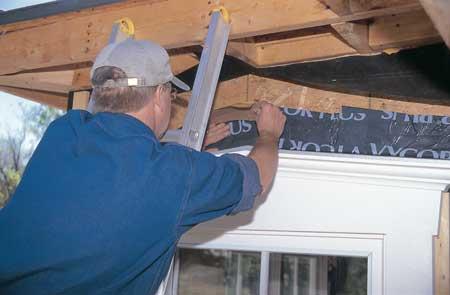
The term "flexible flashing" is used to describe a broad category of nonmetallic flashings, including both peel-and-stick and nonstick flashings. Manufacturers have not yet agreed on a generic term for these products, which are referred to as self-adhering bituminous tapes, flashing tapes, waterproofing tapes, flexible window flashings, flashing membranes, and wall tapes.
Only in the past few years have these flashings become common on residential job sites. Flexible flashing is rapidly replacing traditional felt splines for sealing the perimeter of finned windows. Some flexible-flashing manufacturers promote the use of these products at other locations, as well: to cover below-grade concrete cracks, at roof penetrations, under exterior door sills, over deck ledger boards, at inside and outside corners of wall sheathing, under stucco shelves and parapets, and over sections of wall sheathing susceptible to splashback. But by far the most common use of flexible flashing is at window and door perimeters.
These new materials have some significant advantages over traditional flashing materials. Unlike most metal flashings, for example, peel-and-stick flashings conform easily to unusual shapes. Most types of flexible flashing can be folded to form a waterproof end-dam on a rough windowsill, where making the same shape with copper would require soldering the flashing at the corners. Manufacturers claim that peel-and-stick flashings, unlike metal flashing, can form a waterproof seal between the flashing and the substrate.
These flashings are versatile and easy to install. But before slapping peel-and-stick over every exterior crack, you need to be sure you've chosen the right product for a given application. It's also important to know about potential compatibility problems and to avoid accidentally creating a wrong-side vapor barrier.
Rubberized Asphalt
Most peel-and-stick flashings are made from rubberized asphalt, also known as modified asphalt, modified bitumen, or rubberized bitumen. Rubberized-asphalt membranes were originally developed to protect roofs from ice dams. As builders recognized new uses for the product, several manufacturers began selling it in narrow rolls — typically between 4 and 12 inches wide — for a variety of flashing applications (Figure 1).
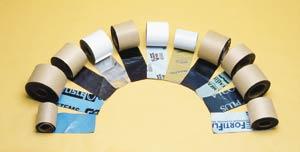
|
| Figure 1. Self-adhering rubberized-asphalt flashings are made of the same material as the eaves membranes used to prevent ice dam leaks. |
Rubberized asphalt used for flashing is made by modifying asphalt with styrene
butadiene styrene (SBS), which makes the asphalt more rubber-like. SBS-modified
asphalt, being elastic, can accommodate thermal expansion and contraction in
building components. Because of its "cold flow" characteristics, rubberized
asphalt can also seal around fastener penetrations.
Sticky stuff. As long as the surface is clean
and warm, rubberized asphalt sticks to a wide variety of substrates: dimensional
lumber, plywood, steel, aluminum, hard vinyl, asphalt felt, and plastic housewrap
(Figure 2). Some manufacturers of rubberized-asphalt flashing advise that their
products may not stick well to concrete, masonry, or OSB unless these substrates
are first primed.
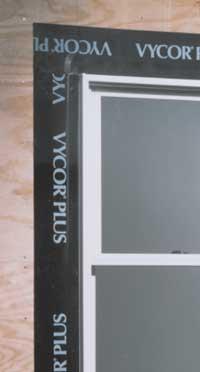 |
Figure 2. Rubberized-asphalt flashings, like Grace's Vycor Plus, stick well to unprimed plywood. Some manufacturers of rubberized-asphalt flashings warn that adhesion to OSB can be difficult unless the OSB is first primed. |
To make it possible to handle such a sticky substance, one side of the rubberized
asphalt is laminated to a thin sheet (usually about 8 mils) of cross-laminated
high-density polyethylene, and the other side is protected with a siliconized
paper release sheet. Instead of polyethylene, some manufacturers laminate a
thin layer of aluminum foil to the top of their rubberized-asphalt flashings
(Figure 3).
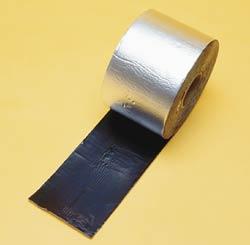
|
| Figure 3. Since foil-topped flashings like Peel'N'Stick from Polyguard Products can be left exposed to the weather for a longer period than polyethylene-topped flashings, they are a good choice when siding installation may be delayed. |
Stickiness is a double-edged sword. In warm temperatures, when rubberized asphalt
is at its stickiest, it can be impossible to readjust a flashing once it has
touched a surface.
Keep it covered. Rubberized-asphalt flashings,
except for those laminated with aluminum foil, should not be left exposed to
the weather. Eventually, ultraviolet light breaks down the polyethylene, exposing
the modified asphalt, which then begins to oxidize. Most manufacturers recommend
that their flashings be covered within 30 days of installation, although one
manufacturer, Protecto Wrap, says that its BT20XL Building Tape can be left
exposed for up to 120 days.
Butyl Rubber
Several manufacturers make peel-and-stick flashings from butyl, also called
butyl rubber (Figure 4). Butyl flashings are usually black, resembling their
rubberized-asphalt cousins. However, butyl flashings lack the asphalt smell
that distinguishes rubberized-asphalt products, and they feel more rubbery.
Like rubberized-asphalt flashings, butyl flashings are available with a top
surface of either polyethylene or aluminum foil. Those with a top surface of
polyethylene should not be left permanently exposed to the weather. FlexWrap,
a butyl flashing from DuPont, has a top layer of corrugated Tyvek that enables
it to conform to curved shapes, like the heads of arch-top windows.
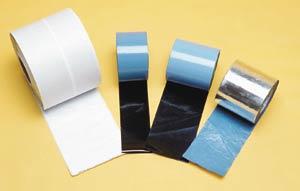
|
| Figure 4. Self-adhering butyl flashings, like rubberized-asphalt flashings, can have a top layer of either polyethylene or aluminum foil. Butyl flashing, although more expensive than rubberized-asphalt flashings, can be installed over a wider temperature range. |
In general, butyl flashings cost about twice as much as rubberized-asphalt products
(see "Flexible Flashing Costs," below). However, DuPont's FlexWrap is significantly
more expensive than other butyl flashings; it costs about six times the price
of the average rubberized-asphalt product. Manufacturers claim that butyl has
several advantages over rubberized asphalt: longer-lasting stickiness, less
staining, less high-temperature oozing, and a wider temperature range for installation.

Butyl rubber has a reputation for long-lived tackiness: One JLC editor
has 21-year-old butyl glazing tape in his greenhouse that is still as pliable
and tacky as the day it was installed. Jeff Winzeler, product manager for the
roofing adhesive group at Ashland Chemical Co. in Columbus, Ohio — a manufacturer
of EPDM and butyl tapes — says, "Compared to SBS-modified asphalt, butyl
is a more high-performance adhesive, with the ability to adhere to difficult
surfaces, and is much more weatherproof." Although butyl's bond is aggressive,
it is slower acting than the bond of rubberized-asphalt products. Butyl manufacturers
tout this as an advantage, because it allows readjustment of the flashing during
installation.
Although rubberized asphalt can be formulated for low-temperature installation,
butyl flashings, on average, can be applied at colder temperatures than most
rubberized-asphalt flashings.
Butyl laminated with EPDM. Some butyl flashings
are laminated to a top layer of EPDM to make a type of flexible flashing called
cover tape or flashing tape (Figure 5). EPDM, a rubbery membrane used for roofing,
is very resistant to weather exposure. Because EPDM flashings are relatively
expensive — costing about six times as much as the average rubberized-asphalt
flashing — they are rarely used anywhere except on roofs, where the ability
to resist ultraviolet light is essential. Where a peel-and-stick flashing will
be covered by siding or otherwise protected, weather resistance is not an issue
and using an EPDM flashing would be overkill.

|
| Figure 5. Butyl flashings with a top layer of EPDM are called cover tape or flashing tape and are commonly used to flash single-ply roofs. The EPDM layer protects the butyl from degradation by ultraviolet rays. |
Moreover, EPDM flashings are so thick (usually about 70 mils) that they would
be awkward to use under siding. Rubberized-asphalt flashings are typically much
thinner — between 20 and 40 mils thick — and are therefore easier
to fold and tuck.
Variations on a Theme
Although most peel-and-stick flashings have a top layer of polyethylene, some
are topped with aluminum foil. A few manufacturers sell flexible flashings that
are not self-adhering and require the use of fasteners (Figure 6).
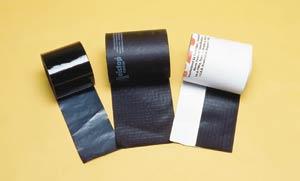
|
| Figure 6. Not all flexible flashings are self-adhering. Future Flash from MFM Building Products (left) and Moistop from Fortifiber (center) are nonstick flashings that are installed with fasteners. Fortifiber's Moistop E-Z Seal (right) is similar to regular Moistop, but includes a 3-inch-wide adhesive band along one side of the flashing. |
Foil-faced flashings. Flashings that are
topped with a thin layer (2 mils) of aluminum foil can be left exposed to the
weather. These flashings, which include an adhesive layer of either butyl or
rubberized asphalt, are promoted for a variety of uses, including repair of
roof-top ducts, metal chimneys, gutters, and trucks.
Because the long-term durability of these flashings is open to question, their
use is usually limited to temporary roof repairs. One manufacturer, Tyco Adhesives,
recommends its aluminum-foil flashing, Polyken 626-20 Window Flashing Tape,
for use at window perimeters. If siding installation is delayed, even for many
months, the aluminum foil layer will still protect the flashing from deterioration.
Nonstick flashings. At least two manufacturers
make nonstick flexible flashings designed to be attached with staples or nails.
Although nonstick flashings may appear unsophisticated compared to peel-and-stick
products, they have their advocates. Some building-science experts feel that
using a nonstick flashing (or even plain asphalt-felt splines) is preferable
to using peel-and-stick flashings, which may be more likely to trap moisture
in wall assemblies.
MFM's Future Flash is a nonstick flashing made from rubberized asphalt sandwiched
between two films, a bottom layer of polyethylene and a top layer of metalized
polyester. According to the manufacturer, Future Flash behaves better in very
hot temperatures than most rubberized-asphalt flashings, because the metalized
polyester layer helps reflect sunlight.
Fortifiber's nonstick flashing, called Moistop, is a relatively thin, 12-mil
flashing made from kraft paper laminated with two layers of polyethylene and
one layer of fiberglass reinforcement. Moistop is inexpensive — about one-third
the cost of the typical rubberized-asphalt product. Moistop shouldn't be used
on windowsills, since the manufacturer warns that it is not intended for horizontal
use. One disadvantage is that unlike Future Flash or other rubberized-asphalt
flashings, Moistop can't seal around fastener holes. Moistop is also available
in a version called E-Z Seal, which includes a narrow band of peel-and-stick
adhesive along one side of the flashing.
|
Using Flexible Flashing * Self-adhering flashings are particularly useful under windowsills and
door thresholds, over deck ledger boards, and at horizontal projections
and parapet walls that will be finished with stucco. |
Choosing the Right Flashing
Not surprisingly, manufacturers are eager to promote their flexible flashing
products for a wide variety of applications. But not all manufacturers recommend
the same applications, so it's important to read the installation instructions.
Some manufacturers recommend using their products below grade or on roofs, while
others specifically exclude those applications. In general, manufacturers of
heavier 35-mil and 40-mil flashings are more likely to recommend roof or below-grade
use than manufacturers of 20-mil products.
Thickness. Flexible flashings vary in thickness
from 12 mils (Fortifiber's nonstick Moistop) to 79 mils (Illbruck Vapor Barrier
Stucco Tape). Most self-adhering window and door flashings range in thickness
from 20 mils to 40 mils. A thicker flashing may be more durable and better able
to withstand abuse, but thinner flashing is easier to fold and conform to unusual
shapes.
Hot locations. In very hot locations, butyl
products are probably a better choice than rubberized asphalt, which can ooze
at high temperatures. Oozing can occur when rubberized-asphalt flashing is installed
under metal exposed to sunlight — for example, under metal roofing or on
the nailing fins of south- or west-facing aluminum-clad windows. Grace Construction
Products specifically prohibits the use of its Vycor Plus flashing in "hot desert
areas in the Southwestern U.S." Similarly, Carlisle Coatings warns that its
product, Window and Door Flashing, is "not recommended in areas where flashing
will be subject to continuous exposure to sunlight or to temperatures in excess
of 180°F."
Cold-weather installation. Trying to install
a peel-and-stick flashing on a cold wall can be frustrating. Both rubberized
asphalt and butyl become less sticky as the temperature drops, and below 40°F
some products just won't stick. One manufacturer, Ridglass Manufacturing, ships
different formulations of their Kwikwrap rubberized-asphalt flashing at different
times of the year, with varying formulations to produce different levels of
low-temperature stickiness. Unfortunately, there is no way to tell from the
Kwikwrap label which product your local distributor has in stock.
The minimum application temperatures provided by flashing manufacturers vary
from 10°F to 50°F (see "Flexible Flashing Specifications," page 4 of
article). These recommendations should be taken as a guide, not a guarantee.
An installer can push the minimum application temperature somewhat by storing
the flashing in a warm location before use.
In consistently low temperatures, the best flexible flashing may be a nonstick
flashing like Fortifiber Moistop or MFM Future Flash. Since these products are
attached with fasteners, stickiness is not an issue. If you need a cold-weather
self-adhering flashing, it's probably best to choose either a butyl product
or Bakor Blueskin Weather Barrier, a rubberized-asphalt flashing that performs
well at low temperatures. In a pinch, any flashing can be held up with roofing
nails.
Compatibility problems. If you're using a
flexible flashing anywhere near an asphalt product, it's best to choose a rubberized-asphalt
flashing, because butyl flashings are incompatible with asphalt products. "There
are oils that want to come out of the asphalt," says Jeff Winzeler. "The butyl
will suck them up and lose its adhesive properties."
Tyco Adhesives' instructions for installing one of its butyl flashing products,
Polyken 627-35, warns, "Avoid contact with residuary asphaltic products such
as coatings and other roofing products." A Tyco representative confirmed that
its butyl flashings shouldn't be in contact with asphalt roofing cement. Since
Tyco promotes the product for use on roofs, where asphalt roofing cement is
often found, installers must be vigilant to avoid compatibility problems.
The jury is still out on whether butyl tapes should be allowed contact with
asphalt felt. "If you are talking about 15-pound felt, there is not a lot of
asphalt, because felts are relatively dry," says Winzeler. "You'll probably
have fewer issues with compatibility than with roofing cement. But until you
test, you can't be sure." When Theresa Weston, a chemical engineer at DuPont,
was asked whether DuPont's butyl tape, FlexWrap, is compatible with asphalt
felt, she was noncommittal. "We're still testing it," she said.
Rubberized asphalt is incompatible with some types of flexible vinyl, especially
vinyl flashings that come in a roll. It doesn't appear to have any compatibility
problems with hard vinyl, like the vinyl used for window fins.
Watch out for staining. Rubberized asphalt, like other asphalt products, can
stain some materials, especially vinyl. According to Bob Sims, customer service
manager at Bakor, such staining, called plasticizer migration, occurs when oils
in the asphalt dissolve plasticizers in the vinyl. Since rubberized-asphalt
flashings shouldn’t be left exposed, staining is generally not a problem.
The siding or other material used to cover the flashing usually hides any stains.
Installing Flexible Flashing
On most job sites, peel-and-stick flashings are installed without a lot of fuss.
Typically, the flashing is cut to length, the release paper is removed, and
the flashing is pressed in place by hand (Figure 7). But the easy way may not
be the right way. Some manufacturers recommend that substrates should be primed
before installing their peel-and-stick flashing, and that pressure should be
applied with a roller, not the palm of the hand.
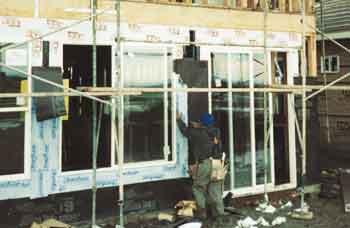
|
| Figure 7. Builders use a variety of methods for flashing windows. This installer has chosen a belt-and-suspenders approach, installing strips of FortiFlash, a rubberized-asphalt flashing, on top of strips of E-Z Seal, a kraft-paper flashing laminated with polyethylene and fiberglass reinforcement. |
Is a primer necessary? Self-sticking flashings
often adhere better to a primed surface than an unprimed surface. Manufacturers
that recommend priming generally focus on concrete and masonry as the most problematic
surfaces, partly because those surfaces can be dusty or damp. Other manufacturers
specify that OSB and gypsum sheathing need to be primed, and a few recommend
priming metal and plywood. Most manufacturers agree that in cold weather, a
self-sticking flashing will adhere better to a primed than an unprimed surface.
There is a Catch-22, though: When it's too cold for peel-and-stick, it may also
be too cold to apply primer.
In any case, few residential builders are likely to take the time to prime plywood
or OSB sheathing before using peel-and-stick, which is one
reason some manufacturers omit the recommendation. If you do decide to prime,
remember to use the primer recommended by the flashing manufacturer, since the
wrong primer may cause compatibility problems.
Hand pressure or roller? Many, but not all,
manufacturers recommend that their flexible flashing should be installed with
a steel or hard-rubber J-roller — the same type of roller used for gluing
plastic laminate countertops. Many manufacturers' reps admit that this recommendation
is widely ignored, but doing so carries some risk: When it comes to priming
and using a roller, the bottom line is that builders who deviate from a manufacturer's
recommendations can't expect any support from the manufacturer if something
goes wrong.
Use With Care
Despite the versatility of flexible flashings, they have their limitations and
must be used with common sense. Some builders have reported adhesion problems
with peel-and-stick. Others note that too much peel-and-stick can create a wrong-side
vapor barrier.
How tacky? Peel-and-stick doesn't always stick.
"I've been to sites where I've seen the peel-and-stick already half falling
off the housewrap," says Patricia McDaniel, owner of Boardwalk Builders in Rehoboth
Beach, Del. Poor bonding can be due to a variety of factors, including low temperatures
and dirty substrates (Figure 8). Manufacturers agree that the adhesive bond
of peel-and-stick flashings varies over time. Initially, for the first month
or so, the bond should actually get stronger. But no one really knows when,
if ever, the bond strength may begin to fail.
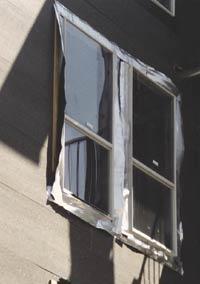 |
Figure 8. Peel-and-stick flashing adheres poorly to dirty substrates or when applied in cold weather. |
Building scientist Joe Lstiburek urges caution. "A problem with these membranes
is that they can peel away," says Lstiburek. "Don't rely on the adhesive property
for waterproofing."
In an informal JLC test, 21 different peel-and-stick flashings were bonded
to wood for 14 hours. About half of them failed to make a waterproof seal. Although
further curing might have resulted in a waterproof bond, the test shows the
need for caution when depending on an adhesive alone to seal out water.
Wrong-side vapor barrier. Peel-and-stick membranes
should be used sparingly on wall sheathing, since they can create a wrong-side
vapor barrier. "If you put a big hunk of peel-and-stick on the sheathing, interior
moisture can condense behind it, causing rot," says Lstiburek. "It doesn't happen
very often, but it happens occasionally. You've got to be careful not to get
slap-happy with the stuff."
Several builders in British Columbia report finding sheathing rot behind peel-and-stick
membranes, especially at window heads. But most investigators say that an important
contributing factor in these cases was the use of damp framing lumber, and there
don't appear to be any reports of such problems in other parts of North America.
In fact, manufacturers of peel-and-stick membranes confidently recommend their
use at window heads. "Clearly, vapor is an issue," says Rick Scruggs, technical
service specialist at Grace Construction Products, a manufacturer of rubberized-asphalt
flashing. "We wouldn't like to see you cover the whole wall, unless there are
provisions for the vapor to get out. But if just a narrow strip of membrane
is used around a window, the vapor can escape from other areas."
Many peel-and-stick manufacturers recommend the use of their products under
siding at areas subject to splashback. However, because of the wrong-side vapor
barrier problem, such an application is controversial. "The use of self-adhering
membrane at splashback areas concerns me greatly," says Bob Switzer, chair of
the Canadian Home Builders Association of British Columbia. "You are far better
off finding ways to prevent the splash, like replacing the soil with lava rock."
Yet many builders confidently use peel-and-stick to protect sheathing from splashback.
"We use it at the splashback area all the time," says McDaniel. "I think you
are much more likely to get water into a structure with bad flashing details
than vapor problems, at least in our climate."
Over or under the housewrap? One debate that
won't be settled soon is whether peel-and-stick should be applied directly to
the sheathing or is best applied to the housewrap or felt. There are strong
advocates for both positions.
Some manufacturers recommend that their peel-and-stick membrane should be applied
directly to the sheathing. "In general, the membrane should be adhered directly
to the wall sheathing, and not to a layer of felt or housewrap. What's the value
of the membrane if it can't be fully adhered to the substrate to prevent water
from getting behind it?" says Scruggs. McDaniel agrees. "Installing housewrap
and then slapping windows in and then attaching peel-and-stick to the housewrap
doesn't do anything," she says.
By contrast, builders who are worried about a wrong-side vapor barrier prefer
to see a layer of building paper or housewrap between the sheathing and the
peel-and-stick. "Rarely do I apply a piece of peel-and-stick directly to sheathing,"
says Randy Faustmann, president of Rainforest Envelope Protection Services,
a consulting firm in Langley, B.C. "Usually, it is installed over the building
paper. I think that having the layer of paper between the peel-and-stick and
the sheathing allows a little bit more drying than it would without it."
No matter how you assemble your sandwich of flexible flashing, nailing fins,
and building paper, everyone agrees on one point: Lap all the layers to shed
water. "You have to lap your layers, because at some point the glue's going
to give," says McDaniel. "Physics is going to win over chemistry."
Martin Holladay is an
associate editor at The Journal of Light Construction.
Cory Eckert is a project developer for the Artisans Group, an Olympia, Wash., remodeling company. He has been in residential construction for the last 16 years.
This article has been provided by www.jlconline.com. JLC-Online is produced by the editors and publishers of The Journal of Light Construction, a monthly magazine serving residential and light-commercial builders, remodelers, designers, and other trade professionals.
Join our Network
Connect with customers looking to do your most profitable projects in the areas you like to work.

